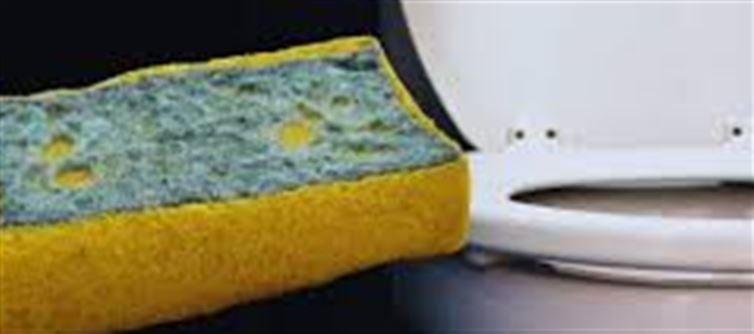
While you work hard to maintain a clean and hygienic home, one common cleaning tool you may overlook could be harboring dangerous bacteria – your kitchen sponge! Yes, your trusty sponge, often used to clean dishes and countertops, is likely the dirtiest item in your house, and it could be a serious health risk to you and your family. Here's why and how you can protect yourself.
1. A Hidden Danger: Kitchen Sponge vs. Toilet Seat
It may surprise you to learn that kitchen sponges often harbor more bacteria than your toilet seat. In fact, studies show that sponges can have up to 200,000 times more bacteria than a toilet seat, with some sponges containing up to 54 billion bacteria per cubic centimeter. These bacteria can easily transfer to any surface the sponge touches, including your dishes, countertops, and food prep areas.
2. How Do Sponges Get So Dirty?
Kitchen sponges are perfect breeding grounds for bacteria for several reasons:
Moisture: Sponges are often kept wet, which creates an ideal environment for bacteria to grow.
Porous Nature: The tiny pores in a sponge trap food particles, oils, and liquids, providing sustenance for harmful microbes.
High Contact with raw Meat: When you use a sponge to clean up after handling raw meat, like chicken, it can become contaminated with Salmonella and other dangerous pathogens.
3. The bacteria Found in Your Sponge
The list of harmful bacteria that can be found in kitchen sponges is lengthy and concerning. Some of the most common and dangerous bacteria include:
Campylobacter: Causes diarrhea and fever.
E. coli: Leads to stomach pain, diarrhea, and can cause kidney damage in severe cases.
Salmonella: Linked to food poisoning and contaminated food.
Staphylococcus: Causes skin infections and can go deep into the body, leading to more severe issues.
Klebsiella, Proteus, Acinetobacter: Known to cause a variety of infections.
Enterobacter Cloacae and Moraxella: Particularly dangerous for people with weak immune systems.
These bacteria can spread to your food, countertops, and hands, making it essential to keep your sponges clean.
4. health Effects: What Can Happen If You Don’t Keep Sponges Clean?
A dirty sponge can lead to a range of health issues, from mild stomach problems to life-threatening infections. Some of the potential risks include:
Stomach upset (e.g., diarrhea, vomiting, cramps)
Pneumonia (lung infection)
Meningitis (inflammation of the brain and spinal cord membranes)
Blood infections (sepsis)
Kidney damage (in severe cases of E. coli infections)
The bacteria lurking in your kitchen sponge are no small matter – they can lead to serious health problems if not addressed.
5. How to Keep Sponges Safe and Clean?
Good news! There are ways to reduce the bacterial load in your kitchen sponge:
a. Microwave Your Sponge
Microwaving your sponge for 1-2 minutes can kill 99.9% of bacteria. However, make sure the sponge is damp (not dry) before microwaving it, as dry sponges could catch fire.
b. Boil Your Sponge
Boiling your sponge in hot water for a few minutes can also kill a significant amount of bacteria. But it’s less effective than the microwave method.
c. Wash Regularly
Wash your sponge thoroughly after every use, and consider replacing it every 1-2 weeks to avoid accumulation of harmful bacteria.
6. Better Alternatives to Sponges
If you’re looking to avoid the potential risks of sponges altogether, here are a few safer alternatives:
Scrub Brushes: They are less porous than sponges and can be easily cleaned or sanitized.
Silicone Brushes: These are non-porous, easy to clean, and resistant to bacteria growth.
Metal Scrubbers: A great option for tough cleaning tasks that don’t require a sponge.
Dish Rags: Wash them in warm soapy water or clean them in the washing machine to keep them fresh and bacteria-free.
Dishwasher: If you have a dishwasher, use it to sanitize your cleaning tools, including sponges and dish rags.
7. Bottom Line: Keep Your home Safer
While sponges are an essential tool in the kitchen, they can quickly become a breeding ground for bacteria if not maintained properly. By following the tips outlined above—such as microwaving or boiling your sponge, and considering alternative cleaning tools—you can significantly reduce the risk of contamination and protect your family’s health.
Remember, it’s not just about cleaning your dishes—it’s about ensuring that your cleaning tools themselves are safe and hygienic. So next time you grab your sponge, consider giving it a quick cleaning to avoid turning your kitchen into a hidden hotspot for bacteria!.jpg)




 click and follow Indiaherald WhatsApp channel
click and follow Indiaherald WhatsApp channel